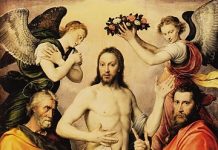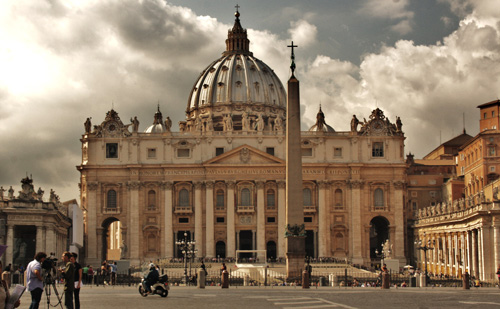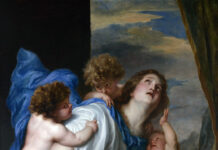Everyone here knows that Advent is the season of waiting. As the readings for the first Sunday indicate, the fundamental characteristic of this time in the Church year is an expression of our longing for the second coming of Christ; and we also, in imagination, place ourselves in the period of preparation for the birth of Jesus, the Messiah, and his appearance as the Saviour of mankind. Thus we see that the significant figures for Advent are the Old Testament prophet Isaiah—that’s the preparation—Our Lady—that’s the appearance—and John the Baptist—that’s the public proclamation of his appearance. The celebration of Mass is quiet, sombre, almost penitential, with purple vestments, subdued music and undecorated church buildings.
But the world cannot wait. Public worship may be subdued, but our streets and stores are aglow with Christmas cheer, or perhaps it would be more precise to say, “aglow with holiday glee.” Carols and Christmas songs greet you at every step, and decorated tress, some of them miracles of ingenuity, have sprouted on every corner. In our society, the feast is celebrated before the date, so that by Christmas day itself, one is so weary of the whole thing that he cannot wait to throw away the Christmas tree; you’ll find the streets littered with them on the feast of Saint Stephen, now, alas, known as ‘Boxing Day’. Good King Wencelsaus would not be pleased.
So, you see, there is a tension between our experience of Advent in church and our anticipation of Christmas everywhere else. What do you think of that? Should we change the form of our worship to fit in with the universal practice of contemporary society by putting up fir trees in the church now and filling the sanctuary with poinsettias? In other words, should we abandon the Church’s traditional mode of celebrating a feast, i.e., after the actual day rather than before?
Let’s be honest. We have already changed. I can demonstrate the change by contrasting the observance of Advent and Christmas which I knew a child with what I do now.
- Consider the Christmas tree. Back then it was set up and decorated on the twenty-fourth, Christmas eve, and it stayed up until what we called “little Christmas,” the feast of the Epiphany on January sixth. That rounded out the celebration of the feast which had continued for twelve days after Christmas. Now, in all the homes I know, including the priests’ residence where I now reside, the tree will soon be up—that is if it’s not already in place. And on boxing day (see above) or the day after, out it goes!
- Next look at Christmas eve. In the old days, it was a day of fast and abstinence. That means no meat was allowed and less food than usual. Nowadays, for many people, including Catholics, it has become the main celebration with a huge meal and the distribution of presents—or some of them, if you face another big feast at the in-laws on Christmas day itself.
- And what about Mass? Once upon a time, the first Mass was at midnight, and there were three different Mass texts, the other two being a Mass at dawn—“The shepherds’ Mass”—and the Mass of the day. Today there are multiple Masses, but they’re celebrated on Christmas eve—5 p.m., 7 p.m. 10 p.m.—and probably not at midnight. These Masses are well attended, generally much more crowded than those on the day itself.
- And how about all those parties? I have mentioned the traditional way of celebrating after the feast, during the twelve days of Christmas. Advent, as I say, was a quiet period, even penitential (though nothing as severe as Lent). Now all the Christmas parties take place during Advent: in schools, businesses and even churches. When I lived in Houston, Texas, the bishop always had a big Christmas dinner for all the clergy and parish workers during Advent, the hall festooned with wreathes and fir tress. There was even a string quartet somewhere, providing suitable music for the occasion.
So, you see. We have altered our observance of Advent, with the sole exception of the celebration of Sunday Mass. My question is, therefore, “Should we make over the liturgy so that it conforms to the rest of our behaviour and actions during Advent? Perhaps the example of Pope Francis will encourage us in this matter, for he exhibits a refreshing willingness to jettison obsolete practices and explore daring ways of bringing the Church up to date. But how can such an updating be accomplished in that as Catholics we base our faith and also the practice of the faith on Tradition as well as Scripture. Well, consider Pope Saint John XXIII, who by summoning the Second Vatican Council back in the 1960s inaugurated a period of what he called aggiornamento, which is Italian for “moving with the times.” He presented the bishops, and indeed, the whole Church with a new attitude to Tradition that guided him and the Council in its deliberations. And what was this powerful tool for aggionamento? It was this: “We change in order to remain the same.”[1] In other words, the Gospel can be proclaimed in new languages, in new cultures, in different societies without surrendering the essential beliefs that we enumerate each Sunday when we say the creed. Well, then, what is the essence of Advent and Christmas for us Catholics? It is simply that Jesus, the eternal Word, was born at a given time and place in history and that, having once appeared among men, he will come again at the end of time. When you think about it, you can see that we commemorate these events every Sunday, and in every season of the Church year. Consequently, the externals of Advent may well be very different in the future from what we know, but the heart of the observation will always be the same, whatever the cultural dress it assumes.
As for me, not surprisingly, I rather like the present form of the liturgy. It provides each week a refuge from the hectic, noisy, commercial atmosphere I am subjected to during the rest of the week.
[1] The actual statement comes from The Development of Christian Doctrine by John Henry Newman; but the sentiment is that expressed by Pope Saint John XXIII in his opening address to the Second Vatican Council.












